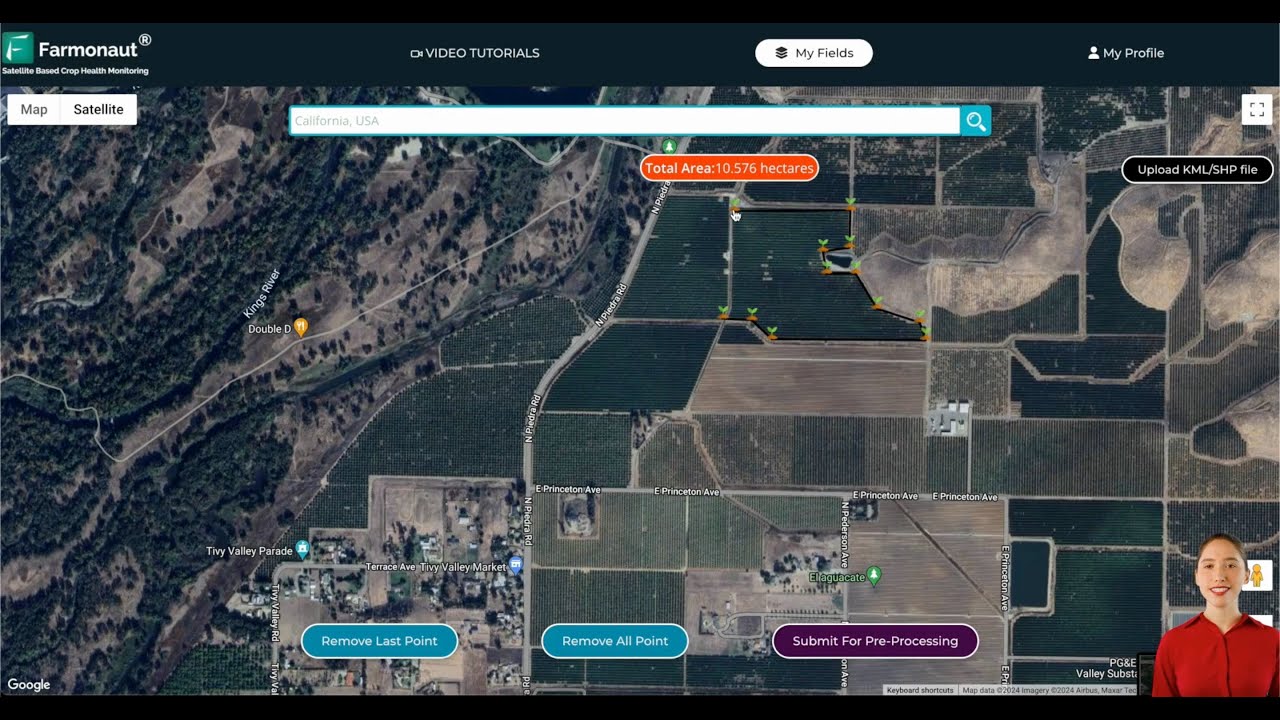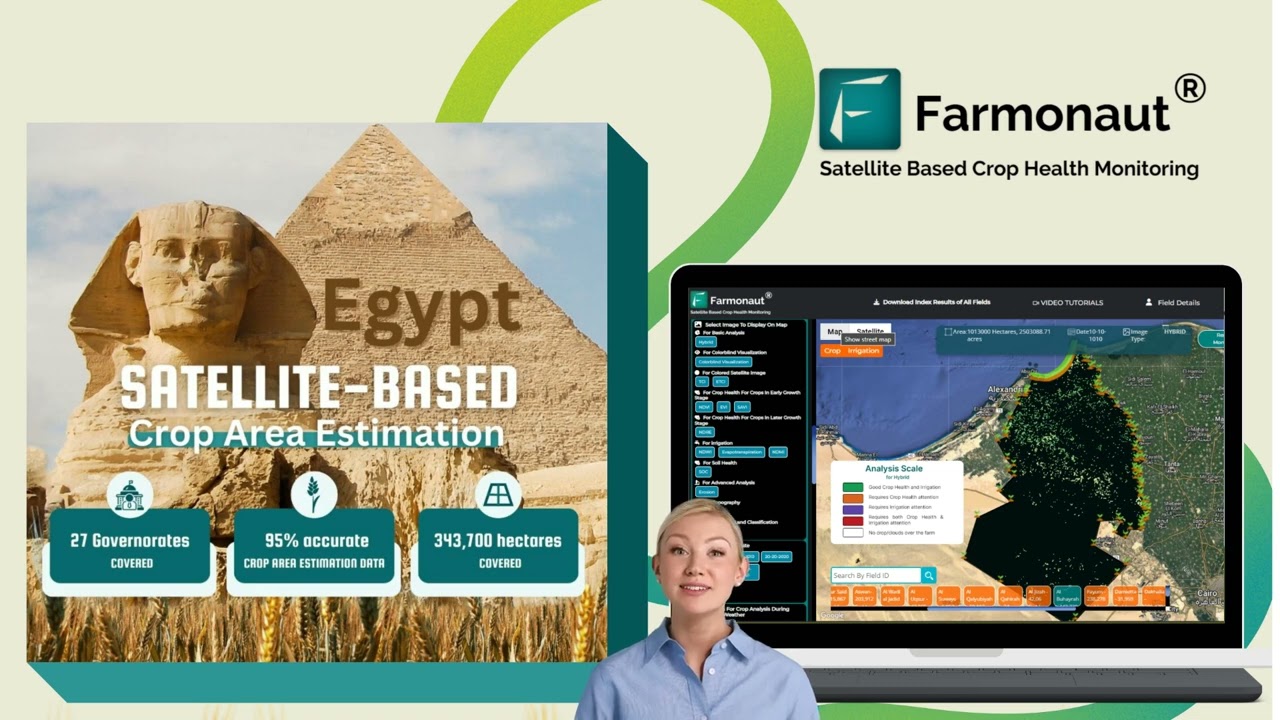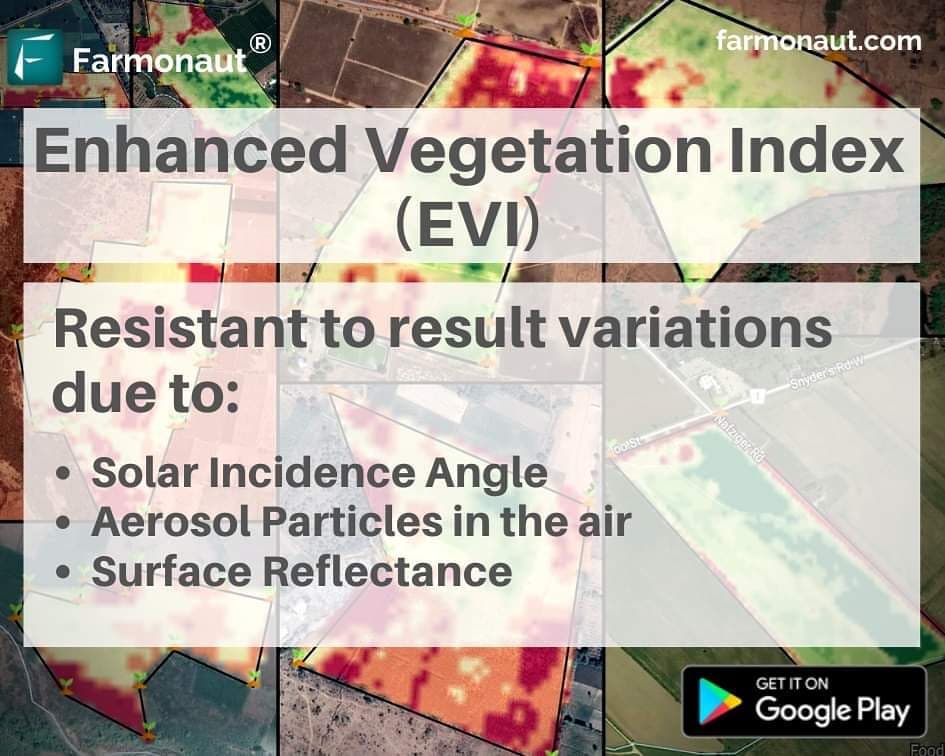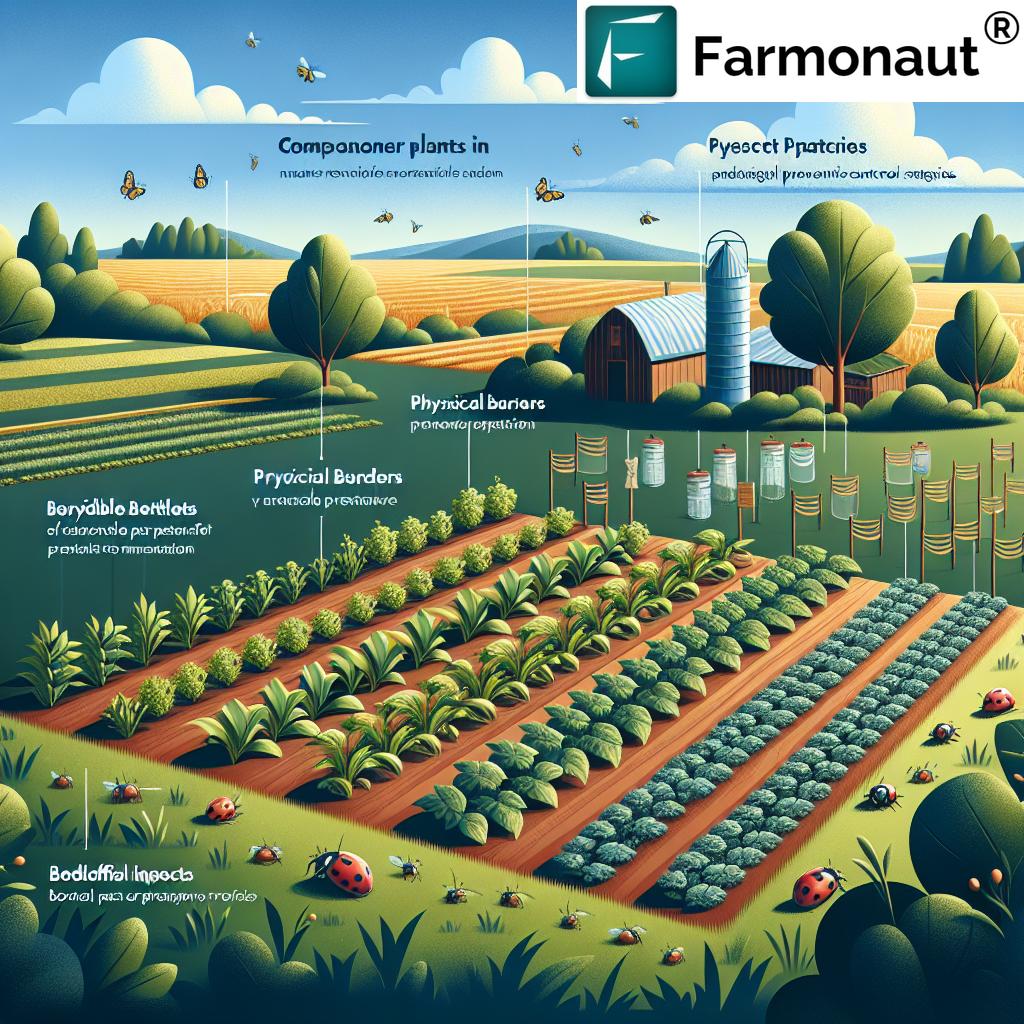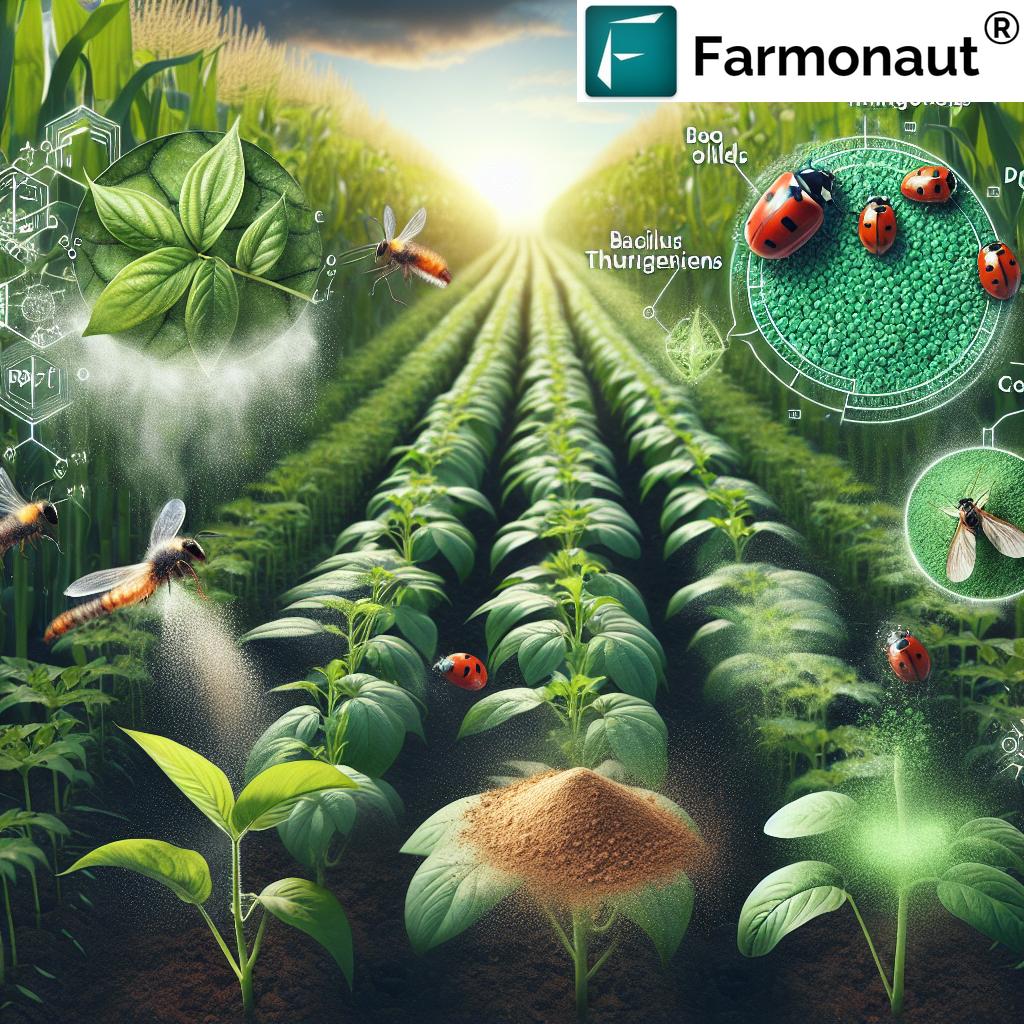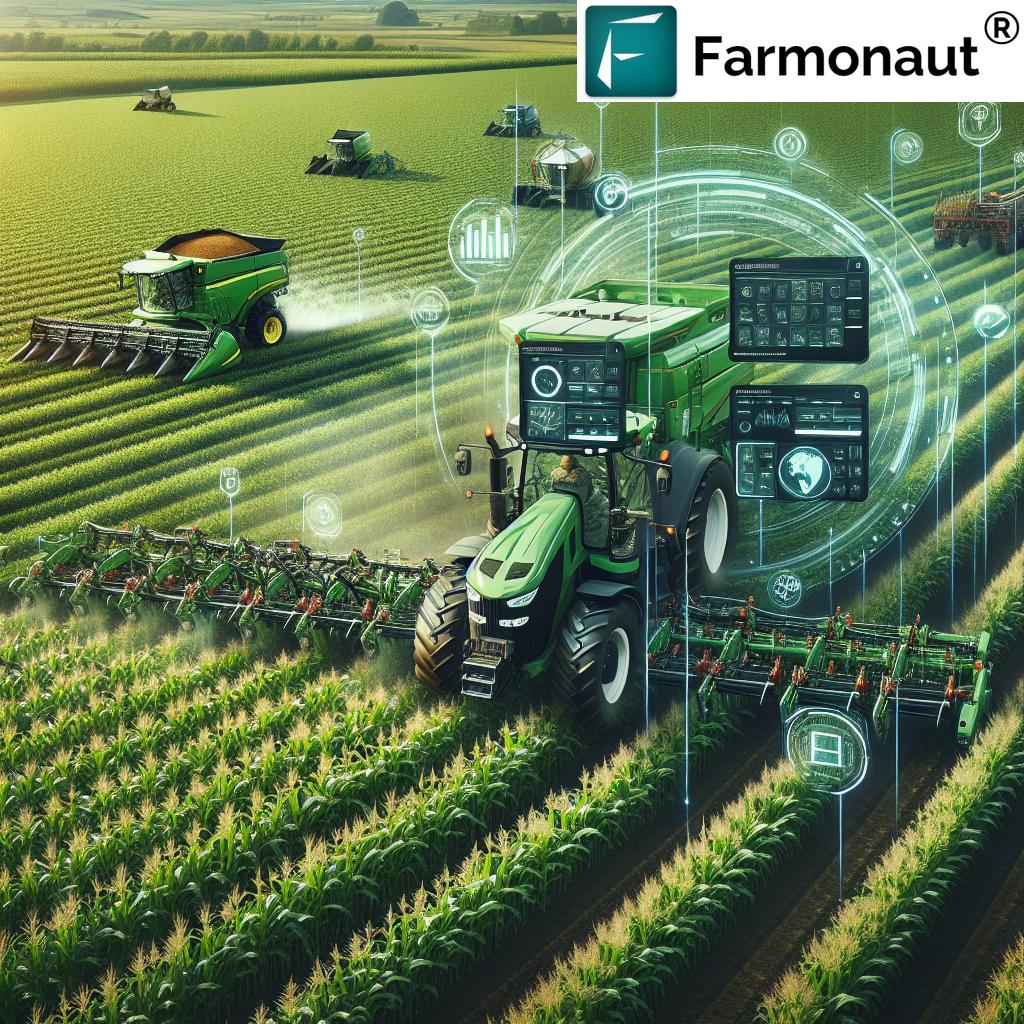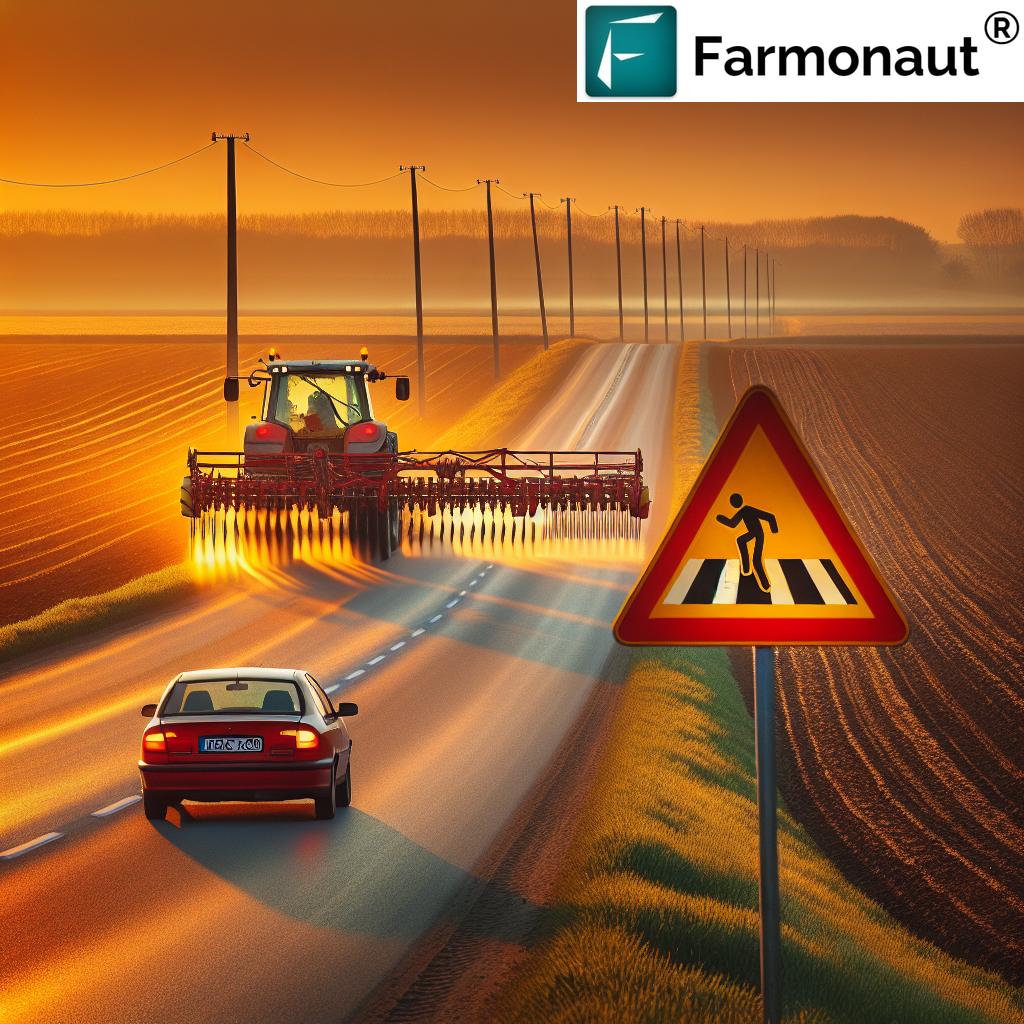Agricultural Vehicles: 7 Types Revolutionizing Farming
Introduction
Historical Development of Agricultural Vehicles
7 Types of Agricultural Vehicles Revolutionizing Farming
Comparison of Modern Agricultural Vehicles and Key Features
Modern Farming Equipment and Precision Agriculture Technology
Impact of Agricultural Vehicles on Modern Farming
Farmonaut’s Role in Precision Agriculture Technology
FAQs on Agricultural Vehicles
Conclusion
Introduction: Transforming Agriculture Through Modern Agricultural Vehicles
Agricultural vehicles have fundamentally transformed the landscape of modern agriculture. What once relied on manual labor or animal power is now driven by powerful, specialized machines that perform a wide range of tasks with unmatched efficiency, speed, and safety. From tractors that serve as the backbone of farming, to sophisticated combine harvesters that handle entire harvesting processes, the evolution of farm machinery has truly revolutionized the industry. As we embrace innovation, vehicles equipped with precision technology and advanced systems are shaping the way we plant, nurture, and harvest crops — supporting our ability to meet the demands of a growing global population.
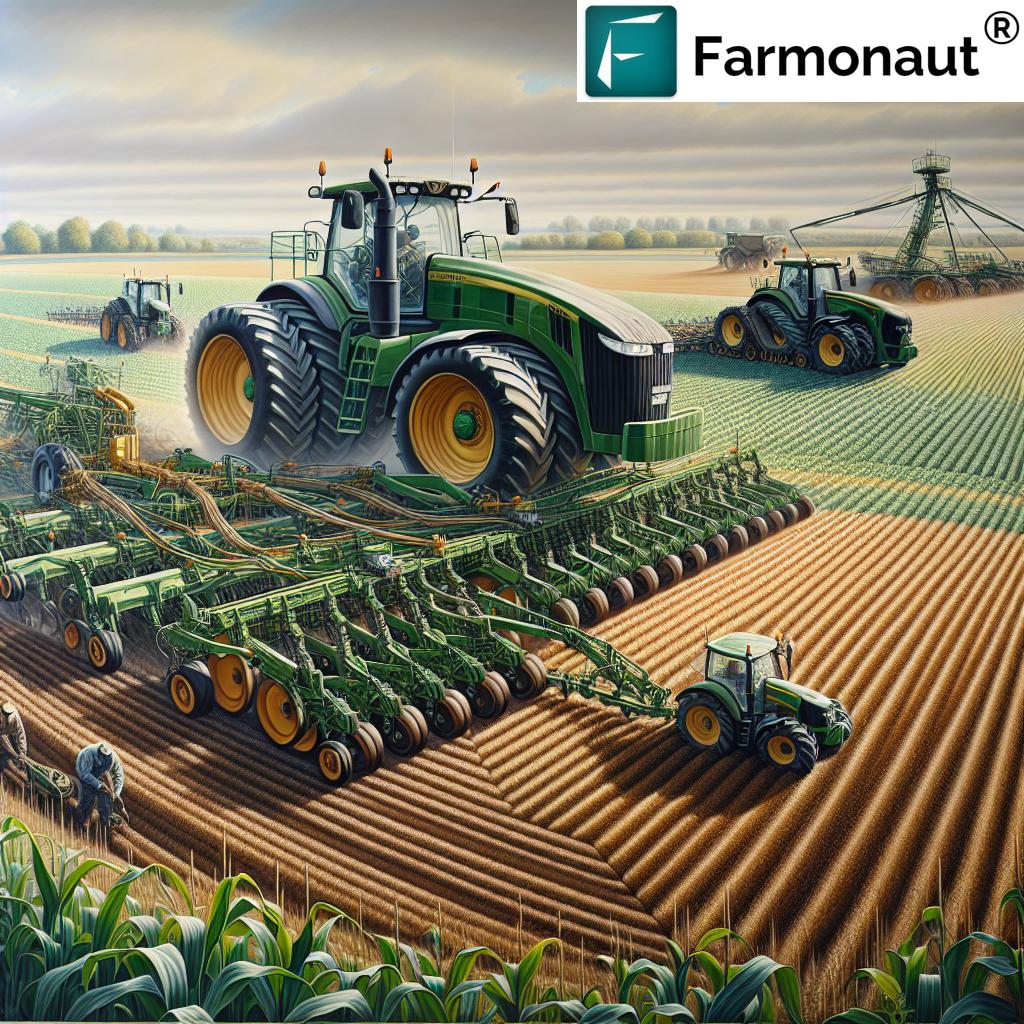
In this comprehensive guide, we explore the wide range of agricultural vehicles that have revolutionized farming — from their historical development to the latest innovations in modern farming equipment and precision agriculture technology. We’ll highlight the most essential types, compare their performance, and discuss their impact on critical agricultural operations.

Historical Development of Agricultural Vehicles
The evolution of agricultural vehicles is a story of relentless innovation and adaptation. Understanding this historical development helps us appreciate why today’s machines are not just convenient — they’re indispensable in modern agricultural practices.
From Manual Labor to Mechanized Power
- Early Innovations: Before the 19th century, farming depended largely on manual labor and draught animals for plowing, tilling, and harvesting crops. The 1830s witnessed the first steam-powered tractors, which, despite their inefficiency and weight, planted the seed for mechanization in farming (amtec-group.com).
- Gasoline & Diesel Engines: The introduction of gasoline engines in the late 19th century brought greater efficiency and versatility. By the early 20th century, diesel engines became the standard, offering improved fuel efficiency and torque (amtec-group).
- Rubber Tires: Replacing steel wheels with pneumatic rubber tires in the 1930s led to better traction, less soil compaction, and faster movement (zehabsd.com).
- Precision Agriculture: The late 20th to 21st centuries saw GPS-guided equipment and computer-controlled systems become commonplace. These enable precision farming practices, optimizing everything from planting to harvest (zehabsd.com).
Throughout this journey, a wide range of vehicles, implements, and attachments have been developed — each designed to automate specific tasks and reduce labor while enhancing productivity. Let’s explore the seven most significant types of agricultural machines that are truly revolutionizing farming today.
7 Types of Agricultural Vehicles Revolutionizing Farming
1. Tractors: The Backbone of Modern Farming
When we think of agricultural vehicles, tractors are the first machines that come to mind. They serve as the primary power source for a multitude of farm implements and attachments.
- Versatile Tasks: Tractors are used for plowing, tilling, planting, hauling, and more, making them indispensable on farms worldwide.
- Attachments: Modern tractors can be fitted with a wide variety of implements, including seeders, balers, and sprayers, allowing a single machine to perform diverse tasks throughout the farming cycle.
- Power and Size: Tractors come in a range of sizes and horsepower, allowing them to tackle everything from small plots to vast commercial operations. Advances such as GPS guidance have improved their ability to work with precision.
These machines have a direct impact on efficiency and productivity. Through improved power and adaptability, tractors have enabled farmers to reduce labor costs and manage larger areas with ease — a true evolution in farm machinery.
2. Combine Harvesters: Streamlining Crop Harvesting
Combine harvesters, often called “combines,” are the ultimate crop harvesting machines. Their design combines multiple processes — reaping, threshing, gathering, and winnowing — in a single operation, efficiently harvesting crops like wheat, corn, barley, and rice.
- Efficiency: One operator can now harvest as much in a day as a team of workers might in a week, reducing labor costs dramatically.
- Technological Advancements: Modern combines are equipped with features like automatic grain loss monitors, precise yield mapping, and integration with GPS systems, contributing to precision agriculture technology.
- Versatility: Combines can be adapted for use in a wide range of crops, enhancing their impact across multiple sectors of agriculture.
By enabling rapid, cost-effective harvesting, combine harvesters have supported not just grain farmers in Punjab or the American Midwest, but modern agriculture worldwide. Precision harvesting minimizes crop loss and increases yields — key goals in improving agricultural efficiency.
3. Sprayers: Precision Application for Crop Protection and Growth
Sprayers are essential for applying pesticides, herbicides, and fertilizers. Today’s self-propelled sprayers are among the most advanced pieces of modern farming equipment, offering highly controlled and precise application of agrochemicals over large areas.
- Variety: Sprayers come in sizes ranging from handheld units for small plots to massive boom-equipped machines capable of treating hundreds of hectares per day.
- Precision: With computer-controlled systems, modern sprayers can adjust spray rates automatically according to GPS maps, minimizing waste and environmental impact.
- Safety and Efficiency: These vehicles help reduce operator exposure to chemicals while improving crop yield and quality.
By enabling precise, efficient application, sprayers play a crucial role in maintaining crop health, improving yields, and reducing input waste.
4. Balers: Optimizing Forage and Straw Handling
Balers are machines designed to compress hay, straw, and forage for storage, transport, or animal feed. They streamline the process of collecting and packaging loose materials into manageable bales.
- Types: Two main types are round balers (producing cylindrical bales) and square balers (producing rectangular bales). Each is suited to differing storage or handling needs.
- Efficiency: Balers reduce manual labor by automating the compressing, tying, and loading of hay or straw bales.
- Versatility: Modern balers are equipped with sensors to monitor moisture and density, allowing for optimal storage and longer shelf life.
Balers are particularly essential for livestock operations, where the consistent quality and preservation of forage is vital. They are a prime example of machines enhancing productivity through efficient handling of crops.
5. Utility Vehicles (ATVs & UTVs): Enhancing Flexibility and Mobility
Utility vehicles, including ATVs (All-Terrain Vehicles) and UTVs (Utility Task Vehicles), have become essential machines for modern farms. Their agility and versatility make them perfect for a variety of tasks, including:
- Transporting equipment, tools, and supplies across large farms
- Herding livestock
- Checking irrigation systems and remote field access
- Spraying small plots or spot-treating crops
These vehicles reduce labor and increase safety for operators traversing difficult terrain. With payload capacities, four-wheel drive, and adaptable attachments, they are true workhorses for efficiency in agriculture.
6. Telehandlers: Lifting and Material Handling in Agriculture
Telehandlers (or boom lifts) blend the best of cranes and forklifts. Within farming and related industries, they are essential for:
- Lifting and transporting heavy loads, such as hay bales, pallets, and feed bags
- Stacking materials in barns or warehouses using telescopic booms
- Reaching high spaces or safely unloading from transport trailers
- Farm infrastructure tasks such as repairing silos, cleaning gutters, and moving construction materials
By significantly reducing manual labor, improving safety, and shortening every material handling process, telehandlers enable busy farms to maximize their productivity all year round.
7. Forage Harvesters: Specialized Crop Harvesting Machines
Forage harvesters are critical for livestock operations. These machines are designed to chop and process forage crops, such as grass, alfalfa, and corn, into high-quality silage for animal feed.
- Self-Propelled or Tractor-Mounted: With adaptable heads for different crops, they match field and crop requirements.
- Speed & Precision: Forage harvesters are equipped with advanced sensors and cutting systems, allowing precise length of cut and consistent nutrition.
- Efficiency: They reduce the time and labor involved compared to manual forage handling and improve the quality of animal feed.
Forage harvesters play a significant role in the efficient management and sustainability of modern livestock farms and dairies.
(Bonus) Livestock Trailers: Safe & Efficient Animal Transportation
While not a “machine” in the traditional sense, specialized livestock trailers are an essential vehicle type for transporting cattle, sheep, pigs, or horses. These trailers are designed with:
- Ventilation systems to ensure animal welfare during transport
- Lighting, feeding, and watering systems
- Secure partitions to prevent injuries in transit
Their role in modern agriculture is vital, supporting efficient operations and reducing stress on animals during all aspects of farm management.
Comparison of Modern Agricultural Vehicles and Key Features
| Vehicle Type | Primary Function | Typical Size/Power (Estimated) | Efficiency Improvement (%) (Estimated) | Precision Technology Usage | Main Crops Served |
|---|---|---|---|---|---|
| Tractor | Power source for multiple farm implements (plowing, tilling, planting, hauling) | 20 – 600 HP (varies by region and operation scale) | +40% | High (GPS auto-steering, variable rate application) | All major crops, including wheat, corn, rice, barley |
| Combine Harvester | Harvesting, threshing, winnowing, gathering in a single process | 200 – 700 HP; widths up to 45ft | +85% | Very High (yield mapping, loss monitoring, GPS integration) | Wheat, corn, barley, rice, soybeans, canola |
| Sprayer (Self-propelled) | Application of pesticides, herbicides, fertilizers | 120 – 350 HP; boom widths up to 40m | +65% | Very High (variable rate, section control, remote monitoring) | All field crops |
| Baler | Compressing hay/straw into bales for storage & transport | 30 – 200 HP (pull-type or integrated); bale weights up to 1 ton | +60% | Medium (moisture/density sensors, auto tying) | Hay, alfalfa, straw, grasses |
| Utility Vehicle (ATV/UTV) | Transport, herding, farm mobility across difficult terrain | 15 – 120 HP; payload: 200–800 kg | +55% | Low–Medium (some have GPS trackers, precision spreading tools) | All (support vehicle, not crop-specific) |
| Telehandler | Lifting, stacking, moving heavy materials on farm | 75 – 250 HP; reach up to 18m | +40% | Medium (load sensors, safety systems) | All (support vehicle, not crop-specific) |
| Forage Harvester | Chopping/processing grass, corn, or alfalfa for silage/feed | 200 – 1000 HP; working widths to 10m | +70% | High (chop-length sensors, yield monitors, GPS guidance) | Corn, grasses, legumes, forage crops |
Modern Farming Equipment and Precision Agriculture Technology
Today’s agricultural vehicles do much more than replace manual labor. Through precision agriculture technology, these machines are equipped with systems that collect, analyze, and respond to real-time data — fundamentally changing the way we manage fields and crops.
Key Innovations in Agricultural Machine Technology
- GPS Guidance: Many tractors and combines now feature auto-steering, ensuring straight rows and perfect overlaps, reducing fuel use and input waste.
- Yield Monitoring & Mapping: Onboard sensors report real-time data on harvest yield, moisture, and more — allowing farmers to spot patterns and improve future practices.
- Variable Rate Application: Sprayers and seeders can be programmed to adjust fertilization, seeding, or spraying rates per field zone, maximizing resource efficiency.
- Telematics & Fleet Management: Connected systems enable remote monitoring of fleets, supporting maintenance planning and optimizing operations. Explore Farmonaut’s Fleet Management solutions to further enhance the efficiency and safety of your farm vehicles.
- Automation & Artificial Intelligence: AI-driven support tools enhance decision-making, equipment scheduling, and resource allocation.
Precision agriculture technology is no longer a luxury; it is now a necessity for improving agricultural efficiency. By integrating these tools, farmers can manage larger areas, reduce inputs, and generate higher yields with reduced environmental impact.
Enhance Your Farm Operations with Real-Time Insights
Farmonaut provides advanced fleet management and resource optimization tools, accessible via web, Android, and iOS. Track vehicle usage, plan logistics, ensure safety, and reduce costs with data-driven insights. Learn more about satellite-based fleet optimization with Farmonaut Fleet Management.
If you are managing plantations, explore Farmonaut Large Scale Farm Management to unlock tools for automated plantation monitoring, operator management, and more.
Impact of Agricultural Vehicles on Modern Farming
The introduction and evolution of agricultural vehicles have revolutionized how we produce food, fiber, and bioenergy. Their impact is visible at every stage of farming:
1. Improving Agricultural Efficiency
- Reduced Labor Requirements: By automating labor-intensive tasks such as plowing, planting, harvesting, and transporting, farmers can handle much larger areas with existing staff.
- Increased Speed: Large machines — from combine harvesters to sprayers with extensive boom systems — speed up planting and harvesting, crucial for timely crop production.
- Higher Productivity & Yields: Machines operate tirelessly, day or night, with consistency and accuracy that manual labor can’t match, resulting in improved yields and efficiency.
2. Enhanced Precision and Sustainability
- Precision Input Usage: Targeted dosing for fertilizers and pesticides reduces waste, minimizes runoff, and preserves environmental health.
- Sustainable Resource Management: Reduced tillage options, carbon footprint monitoring, and efficient fuel use all support sustainable practices. Explore sustainability tracking with Farmonaut Carbon Footprinting.
3. Safety and Farmer Wellbeing
- Farm Equipment Safety: Enclosed, ergonomic cabs, roll-over protection, and real-time alerts minimize accident risks for operators.
- Reduction in Physical Strain: Mechanization dramatically decreases backbreaking manual labor, making farming more accessible and reducing workplace injuries.
4. Economic Viability & Meeting Global Demand
- Lower Costs, Higher Returns: Efficiency gains mean lower input and labor costs, increased yields, and improved viability for farms of all sizes.
- Supply Chain Transparency: Technologies such as blockchain enable product traceability — see Farmonaut’s trusted Product Traceability solutions for how you can add verification from farm to shelf.
-
Facilitating Crop Loans & Insurance: Remote sensing and satellite data now allow for instant verification of farm activities, reducing fraud and simplifying finance.
Learn more about Farmonaut Crop Loan and Insurance solutions and how they empower both farmers and financial institutions.
Farmonaut’s Role in Precision Agriculture Technology
As modern agricultural vehicles become more technologically sophisticated, the need for reliable, actionable data is critical. Farmonaut is a pioneering agricultural technology company making precision agriculture affordable and accessible across the globe, especially for users in regions like India, Asia, Africa, and South America.
How Farmonaut Empowers the Next Generation of Farmers
- Satellite-Based Monitoring: Our platform uses satellite imagery to track crop health, soil moisture, and other vital metrics, helping farmers make smarter decisions about watering, fertilization, and pest management.
- AI-Based Advisory Systems (Jeevn): Get personalized, real-time insights — from optimal planting times to harvest recommendations — directly within your mobile or web app.
- Blockchain-Based Traceability: Enhance product transparency and build consumer trust with verifiable, tamper-proof supply chain records.
- Fleet and Resource Management: Monitor all your vehicles, reduce fuel costs, schedule maintenance, and promote farm equipment safety — all within one platform.
- Carbon Footprinting: Measure and reduce your environmental impact using real-time carbon tracking, vital for sustainable farming.
We offer our solutions via Android, iOS, web apps, and directly via API. If you’re a developer or agritech business, discover how to build your own apps or analytics tools using our API and get detailed integration support in our Developer Docs.
Whether you’re a smallholder, a large agribusiness, or a government institution, Farmonaut’s scalable solutions can transform your approach to data-driven agriculture.
Subscribe To Farmonaut and Transform Your Farm Operations
FAQs on Agricultural Vehicles
-
What are agricultural vehicles, and why are they important?
Agricultural vehicles refer to machines and specialized vehicles designed for various farming operations such as plowing, planting, spraying, harvesting, and hauling. Their significance lies in their ability to improve efficiency, enhance productivity, and ensure safety in farms by automating and optimizing key agricultural tasks.
-
How have tractors transformed farming efficiency?
Tractors, by serving as a primary power source for multiple implements, have enabled farmers to cultivate larger areas, reduce manual labor, complete fieldwork more quickly, and improve operational efficiency by up to 40%.
-
What role does technology play in modern agricultural vehicles?
Technology such as GPS, telematics, AI advisory systems, and remote monitoring enables precision agriculture practices. This transforms machines into data-driven platforms, allowing for accurate input application, reduced environmental impact, and efficient fleet management.
-
Are agricultural vehicles affordable for small and medium farms?
Yes. Many vehicles are available in a range of sizes and prices. Moreover, technologies like those offered by Farmonaut make advanced data tools affordable and accessible, allowing smallholder farmers to leverage precision agriculture without the need for expensive hardware.
-
What is the role of combine harvesters in crop harvesting?
Combine harvesters automate the process of reaping, threshing, gathering, and winnowing, significantly reducing harvesting time and labor costs while improving grain quality and yield.
-
How do agricultural vehicles contribute to sustainability?
By enabling targeted input use, reducing soil compaction, and supporting data-driven decisions, these vehicles help optimize resource usage and reduce emissions, thereby making farming practices more sustainable.
-
Can modern agricultural vehicles be monitored or managed remotely?
Yes. Through fleet management platforms and systems like Farmonaut, farmers and agribusinesses can monitor, optimize, and schedule maintenance for their entire vehicle fleets from anywhere.
-
How do I get started with precision agriculture technology?
Begin by embracing data-driven solutions like satellite monitoring, soil health tracking, and AI-based advisories. Farmonaut provides user-friendly tools—accessible via web or mobile—that help you adopt precision farming easily.
Conclusion: The Future of Agriculture is Driven by Innovation
The agricultural vehicles and machines discussed here are far more than mere mechanical aids—they are pillars of a globally interconnected food system that sustains billions. Tractors and combine harvesters have transformed not only farming practices in India, the US, or Europe, but have delivered increased efficiency, productivity, and safety worldwide. Meanwhile, technologies like precision agriculture, AI, and blockchain traceability—delivered via platforms like Farmonaut—equip all of us with the tools for a more sustainable, transparent, and prosperous agricultural future.
Whether you are looking to reduce manual labor, enhance crop yields, ensure the safety of your farm staff, or adopt data-driven, sustainable practices, embracing modern agricultural vehicles and precision agriculture technology is the key. With accessible solutions, actionable data, and a commitment to innovation, we can all be part of the next generation that feeds the world more efficiently and responsibly.
Ready to revolutionize your farm? Try Farmonaut today via our web and mobile apps or integrate our API into your agri-business for custom solutions.
Discover the power of smart agriculture and join the movement that’s shaping the farms of tomorrow.





